“], “filter”: { “nextExceptions”: “img, blockquote, div”, “nextContainsExceptions”: “img, blockquote, a.btn, a.o-button”} }”>
Heading out the door? Read this article on the new Outside+ app available now on iOS devices for members!
>”,”name”:”in-content-cta”,”type”:”link”}}”>Download the app.
Yoga is commonly misunderstood as a practice that only helps you become more flexible or, if you will, bendy. It’s also an underestimation of what it can do for you. But it’s also true that it can help you experience significant strength gains, particularly in the smaller muscles that are easily overlooked in gym workouts. Practicing common yoga for strength poses challenges these muscles and not only increases stability throughout your body but helps prevent aches and strains from these muscles being overworked.
The following yoga for strength practice supports full-body strength without requiring you to go to the gym or work with external weights.
11 Ways to Practice Yoga for Strength
Rely on the following poses as a sequence or incorporate a few of them into your regular gym workout.
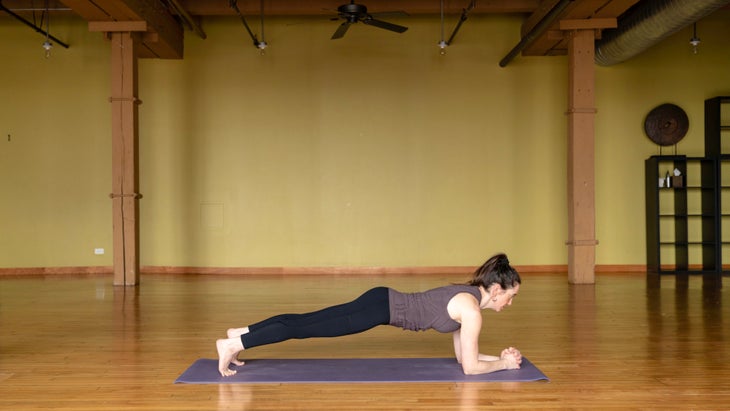
1. Forearm Plank
Start on your hands and knees and lower your elbows to the floor, placing them shoulder-width apart. Interlace your fingers and tuck your bottom pinky finger so it doesn’t get squished. Press through the length of your forearms to the base of your wrists. Keep your toes tucked as you straighten one leg at a time and hold yourself parallel to the floor in Forearm Plank. Draw your navel toward your spine and push through your heels as you focus on your breath. Gaze slightly forward and down toward your thumbs. Breathe here for 1 minute or longer.
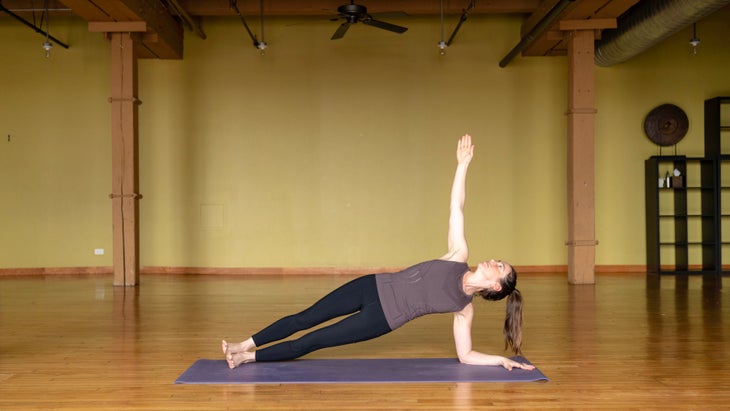
2. Forearm Side Plank
From Forearm Plank, keep the same engagement as you slowly lean onto your left forearm, pressing down firmly from your elbow to your wrist. You can place your forearm at a diagonal for steadiness. Keep your palm flat on the mat or make a fist. Slowly roll onto the outer edge of your left foot and keep your feet staggered on the mat or stack your right foot atop your left. Hug your legs together and use your core for support to balance in this pose. Rest your top hand on your top hip or slowly reach it toward the ceiling. Stay for 5 to 10 deep breaths.
Slowly transition through Forearm Plank and then repeat on the right side.
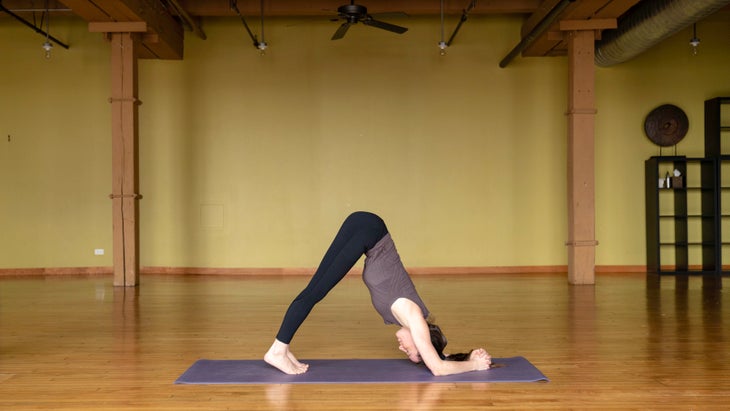
3. Dolphin Pose
From Forearm Plank, start to walk your feet toward your hands. Dolphin is just like Down Dog except you are on your elbows instead of your hands. If your hamstrings are tight, bend your knees and don’t worry if your heels don’t touch the floor. Keep your feet and legs hip-distance apart and gaze at your feet. Press down and forward with your forearms as you lift your shoulders toward the ceiling and your chest toward your thighs. Stay here for 5 breaths.
Lower onto your knees to rest.
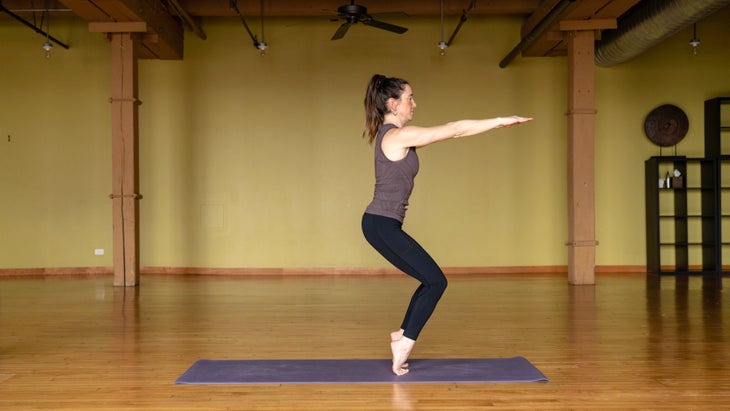
4. Chair Pose on Tiptoes
Come to stand at the top of the mat with your feet hip-width apart. Make sure your feet are parallel. Lift your arms straight in front of you at shoulder height with your palms facing each other or the mat. On an inhalation, lift your heart; on an exhalation, bend your knees and shift your hips back in space, as if you were going to sit back in Chair Pose. Lift your navel toward your spine and keep your breath even and smooth. Hold this position as best you can and begin to lift your heels off the floor to balance on your toes. (If you have any toe issues, keep your feet flat on the floor.) Breathe here as long as you can before lowering your heels and straightening your legs.
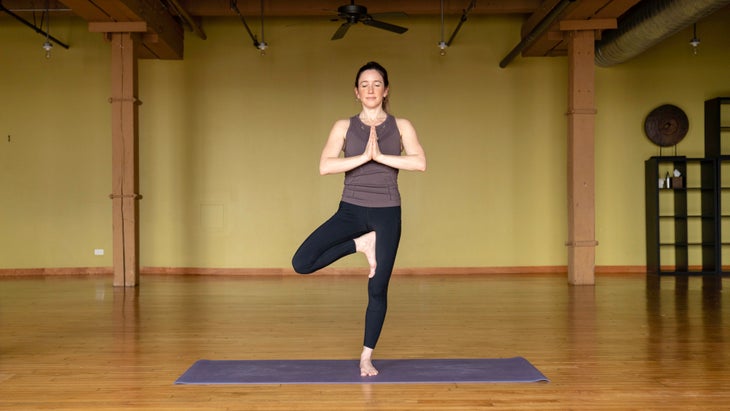
5. Tree Pose
Stand tall at the top of the mat. Shift your weight into your left foot and draw your right knee toward your chest. Hold your right ankle with your right hand and place your foot against your upper inner left thigh, just below your knee or against your ankle in Tree Pose. Press your upper left leg against your foot and your foot against your leg. Try to keep your hips level to the floor, making sure one hip is not higher than the other. Bring your hands to Prayer Pose in front of your chest. Keep your gaze, or drishti, focused straight ahead on a single point in front of you. Stay here or raise your arms overhead, keeping your hands shoulder-width distance, and spread your fingers wide, reaching your fingertips toward the ceiling. Breathe evenly here. If you feel steady, try closing your eyes. Release the pose after 5 to 10 breaths. Switch sides.
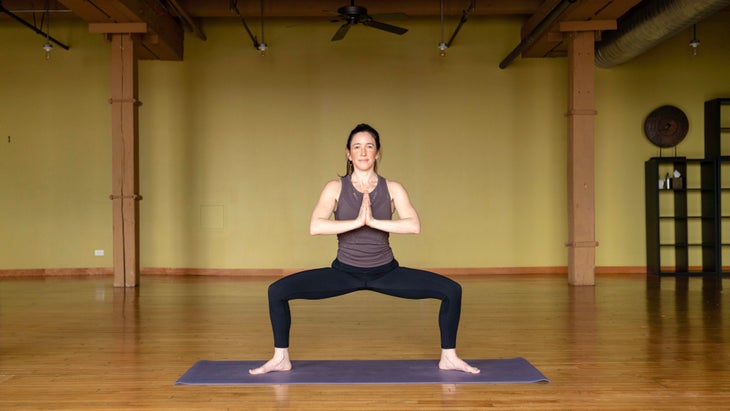
6. Goddess Pose
Face the long side of the mat and take a wide stance with your feet 3 to 4 feet apart. The taller you are, the wider you’ll want your stance. Angle both feet out about 45 degrees and then bend your knees, making sure your knees are pointing toward your toes. (Don’t let your knees collapse inward or outward.) Stack your knees over your heels and lift through your low belly, making sure your torso is upright. Place your hands in Prayer Pose in front of your chest and stay here for 1 minute or longer. Notice if your lower back is arching and, if so, draw your navel to your spin to correct that.
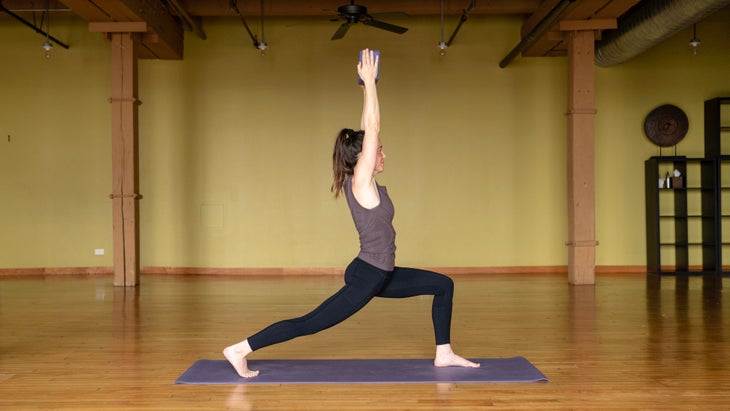
7. High Lunge
From the top of your mat, take a big step back with your right foot. Keep your hips and shoulders squared forward toward the front of the mat. Your stance should be long enough that your front leg is at approximately a 90-degree angle. Stack your knee on top of your ankle and point the center of your front knee toward the second toe of that foot. Lift your lower belly away from the front of your front leg and keep your chest perpendicular to the floor as you reach your arms alongside your head in High Lunge. Press your back heel toward the wall behind you, lift your inner back thigh toward the ceiling, and try not to collapse in your lower back. On an inhalation, push down with your front foot, straightening your front leg. On an exhalation, come back to the bent leg position. Repeat, moving with your breath, 5 to 10 times before switching sides.
Variation: If you have a block handy, hold it between your hands as you lift your hands overhead. The block should be in its widest position. Squeeze your hands on the block and imagine you’re trying to lift it toward the ceiling.
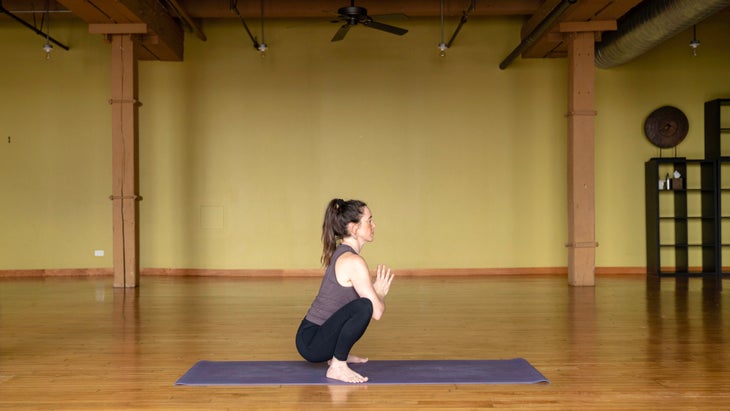
8. Squat
Stand in the middle of your mat facing the short edge with your feet about as wide as the mat and angled outward as they were in Goddess. Bend your knees as much as you can and keep them pointing in the same direction as your toes in a Squat. Bring your hands to Prayer Pose in front of your chest. If your heels are lifted off the mat, either roll the back of the mat and rest your heels on that or bring your hands to the mat in front of you for support.
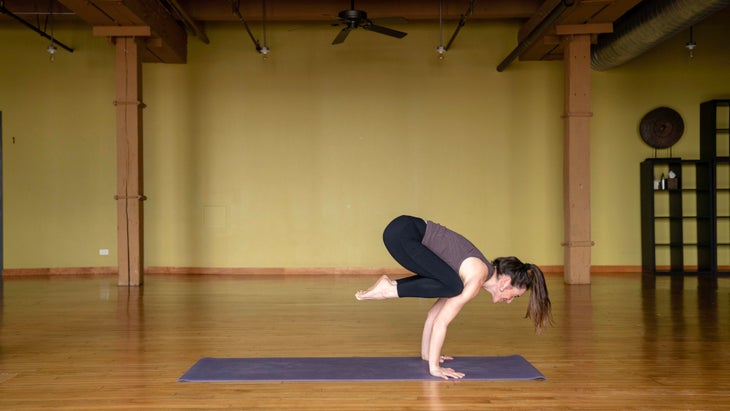
9. Crow Pose
From Squat, walk your hands forward toward the short side of the mat and begin to round your spine. Start to lift your hips but keep your heels on the mat. Keep the rounding in your back and bring your hands in somewhat so they’re about 12 inches in front of your toes. Separate your hands shoulder-width distance apart and spread your fingers wide. Shift your gaze forward and down and bend your elbows slightly, as if you were starting to come into Chaturanga or Low Push-Up. Place your knees on the backs of your upper arms, as if the arms were a shelf, and keep hugging your fingertips into the mat. Start to lean your weight forward and come onto the balls of your feet and then your toes. Keep your chest and gaze facing forward and continue to push firmly down with both hands. Continue to slowly shift your weight forward and lift one or both feet off the mat. When you’re balancing on your hands, lift one or both heels toward your hips. If both feet are lifted, draw your big toes to touch in Crow Pose. Breathe here and then slowly release.

10. L-Pose
Make your way to a wall and come onto your hands and knees, facing away from the wall, with your toes tucked under touching the wall. Your hips will be over your knees, your shoulders stacked over your wrists, and your hands shoulder distance apart. Spread your fingers wide and press down into both hands, especially pressing down with your thumb and index fingers, then start to lift your hips up. (It will feel like you’re moving into a short Down Dog.)
Keep your hands grounded and arms straight and start to walk your feet up the wall. Bring your feet up to hip height and no higher. Bend your knees slightly and press your chest toward the wall. If your hamstrings are open enough to straighten your legs, feel free to do that here. However, if you try to straighten your legs and it pushes your chest forward, keep your knees slightly bent. Continue to press firmly down with both hands and keep your arms straight as you gaze toward the wall. Stay here for a few breaths and then walk your feet down the wall and rest on your knees.
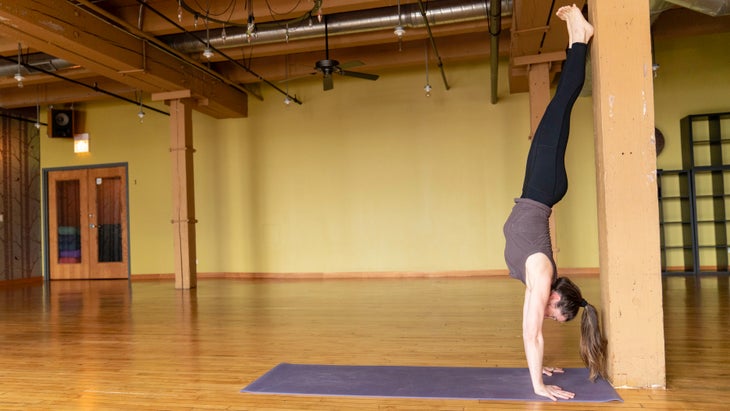
11. Handstand
This is a hard pose, especially if you’re new to it, so try to have a positive approach and know that you’re doing your body a lot of good, even if it takes a while to get up.
Come onto your hands and knees facing a wall, with your hands about one full hand length away from the wall. Line up your hands so they’re shoulder-width distance apart and make it a little wider if your shoulders feel tight. Spread your fingers wide, pressing firmly down into both hands. Shift your gaze forward to the space between your thumbs and hold your gaze there. Feel your outer upper arms firming in and keep your arms straight and strong as you tuck your toes under and lift your hips. You will feel like you’re in a short Down Dog. From here, step or kick up in Handstand. Don’t worry if you don’t get all the way up at first; it takes practice! Once you’re up, bring your heels together and reach them toward the ceiling, keeping your gaze between your thumbs the entire time.
RELATED: 5 Strength-Building Yoga Poses for Beginners
This article has been updated. Originally published February 14, 2019.


